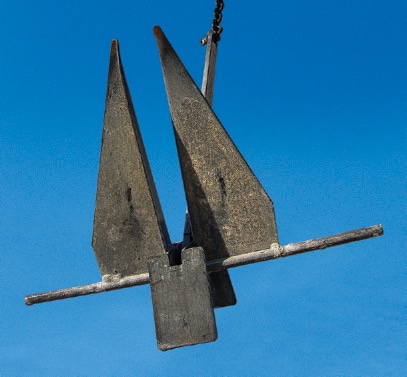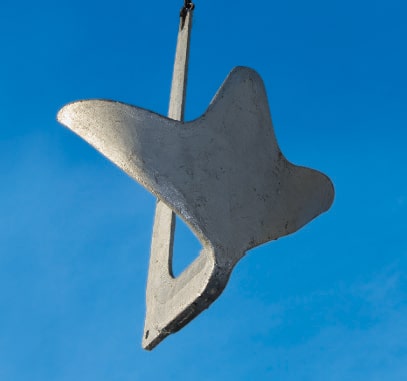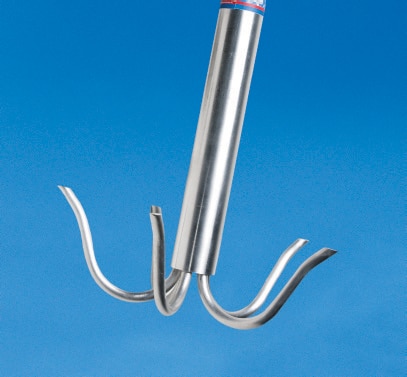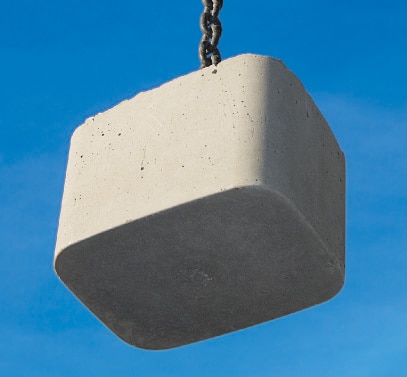Trolling and drift fishing are super productive, but sometimes anchoring on a spot is the best way to catch fish. Which one of these hooks best suits your style of fishing?

Pivoting Fluke
At A Glance: Used to pull landing craft off World War II beaches, pivoting fluke anchors such as the Danforth (danforthanchors.com) or Fortress (fortressanchors.com) are among the most common fishing anchors — and with good reason. This reliable design works well in a variety of seabeds.
Weight and Cost
20-Foot Boat: A Danforth Deepset II Hi-Tensile 5-pound anchor sells for around $98, and a 9-pound Standard model will set you back $42.
35-Foot Boat: Danforth’s Deepset II Hi- Tensile 8.5-pound anchor runs approximately $122; the 7-pound Fortress counterpart costs about $250.
Best For: Fluke anchors excel in sandy, lightly silted or hard-mud bottoms and also perform well in clay, shell or rocks.
Watch Out: Not the best choice for grass, deep mud or silt, where it tends to drag or pull free; may also foul and false-set on rocky or debris-strewn bottoms. Avoid el cheapo models; you’ll realize better performance from upper-level units.
Bottom Line: Featuring a high holding-power-to-weight ratio, these moderately priced hooks provide a lot of bang for the buck. A fisherman’s friend, for sure.

Claw
At A Glance: Designed to secure North Sea oil rigs, claw anchors — such as Bruce anchors, Lewmar’s Horizon Claw (lewmar.com) and Manson Ray (mansonmarine.co.nz) — set quickly and deliver reliable holding power under a range of conditions. Although heavier than Danforth types, they’re a great choice for serious fishing.
Weight and Cost
20-Foot Boat: Expect to drop $40 or so on an 11-pound claw from Lewmar.
35-Foot Boat: A 44-pound Manson Ray 20 costs $865 and is Lloyd’s certified as high holding power, while a 33-pound Lewmar Horizon Claw goes for about $100.
Best For: Claw anchors shine in sand, mud and clay and are stout enough for rocky neighborhoods. This is a supremely versatile design.
Watch Out: Like many anchors, claw types may have trouble holding in heavy vegetation or extremely hard bottoms, where they may skip. Unwieldy, they are best stowed on anchor rollers or pulpits.
Bottom Line: Delivering great holding power, this hook resets quickly if changes in wind or current cause it to slip. An added plus: It maintains its bite even with short scope — which minimizes your chances of swinging off the hot spot. Dig it!

Grapnel
At A Glance: Grapnels like Mighty Mite (mightymiteanchors.com) or MarPro (pbsboatstore.com) rely on grabbing action — rather than bottom penetration or sheer weight — to develop holding power. Easy-to-stow folding models are available, but you can also buy or make grapnels with bendable prongs fashioned from rebar, aluminum or stainless rod.
Weight and Cost
20-Foot Boat: Grapnels generally weigh 9 to 13 pounds and are priced from $28 to $80. Models with bendable prongs can be nearly any size.
35-Foot Boat: Though grapnels are not always the best choice here, a 33-pound anchor costs about $92.
Best For: Coral, rock or timber-infested bottoms are where bendable grapnels work best — the prongs will straighten as you retrieve a fouled anchor. Simply bend them back into shape and you’re good to go.
Watch Out: If there’s no structure for the grapnel to catch, you’re better off deploying a more traditional hook, such as a fluke or claw-style.
Bottom Line: Always use chain with grapnels — not only for chafe protection but also because the longer and heavier the chain, the less scope you’ll have to pay out.

Cement Can
At A Glance: More fish have probably been caught from boats using cement-can anchors than any other style of hook. A bit rustic, perhaps, but you can’t beat this American tradition’s simplicity and value.
Weight and Cost
20-Foot Boat: A bag of cement and an eye bolt will set you back a couple of bucks. Most cement-can anchors weigh between 5 and 15 pounds — and you can tailor the weight to your needs.
35-Foot Boat: Fuggedaboutit. To secure a sizable boat in any kind of weather, a homemade, cement anchor would be too heavy to handle.
Best For: This one’s best left to small boats and calm, inland waters. It holds mainly by weight, so it can be especially effective in heavy grass.
**
Watch Out:** Rounded-can designs (like a coffee tin) roll on deck and drag more easily than blocky shapes, so pay heed when choosing a form into which to pour your anchor.
Bottom Line: What cement anchors lack in panache they more than make up for in cost and practicality — just make sure it’s not the only anchor you carry on board.








